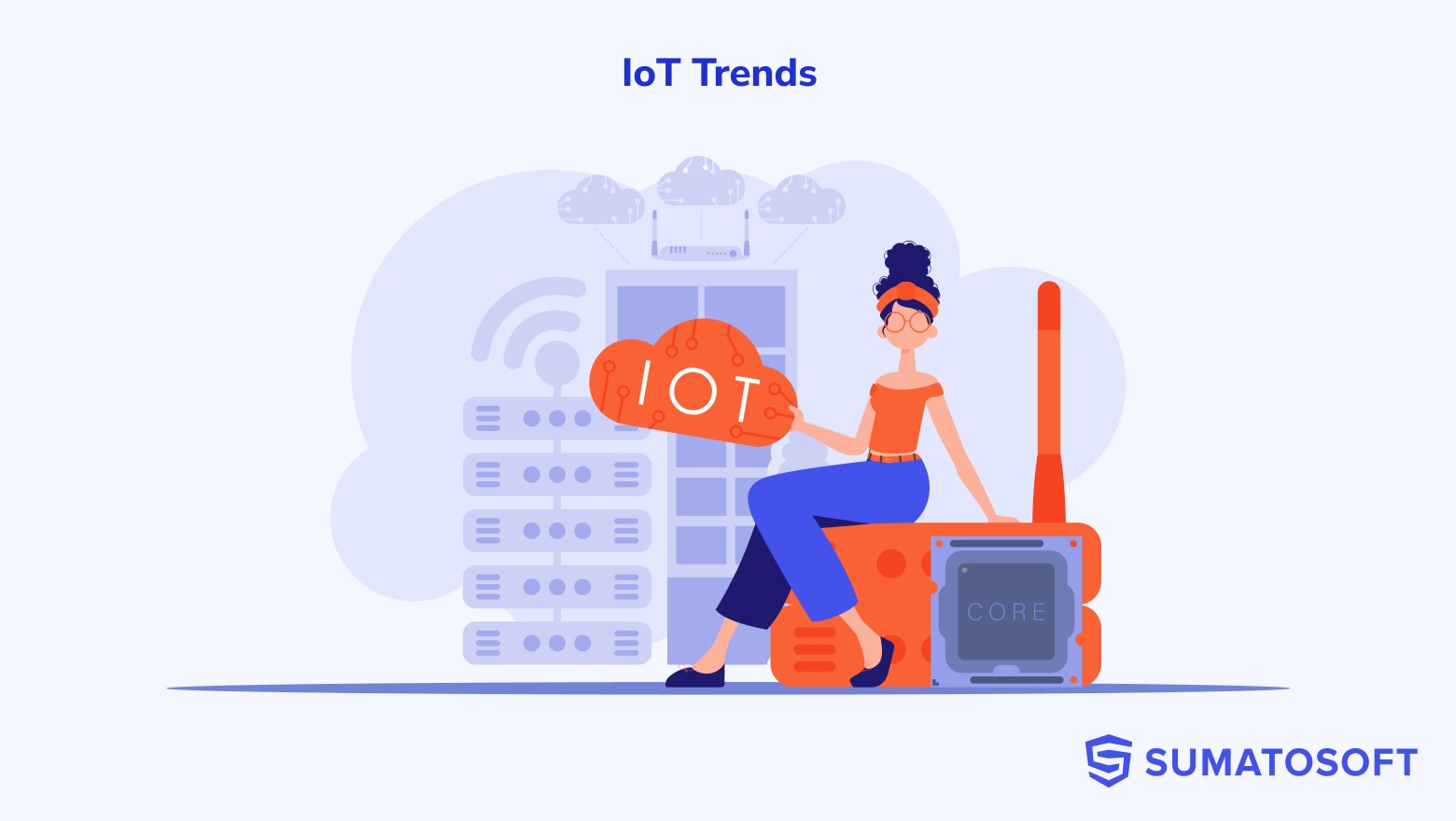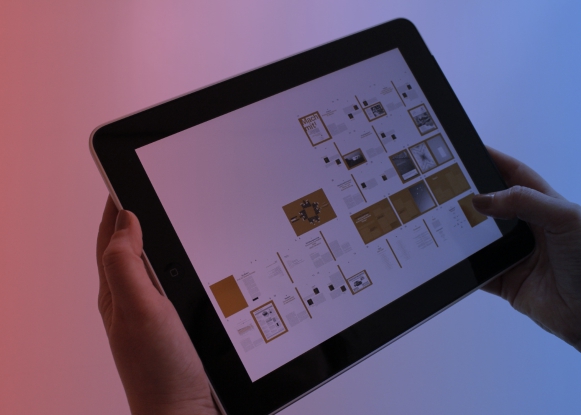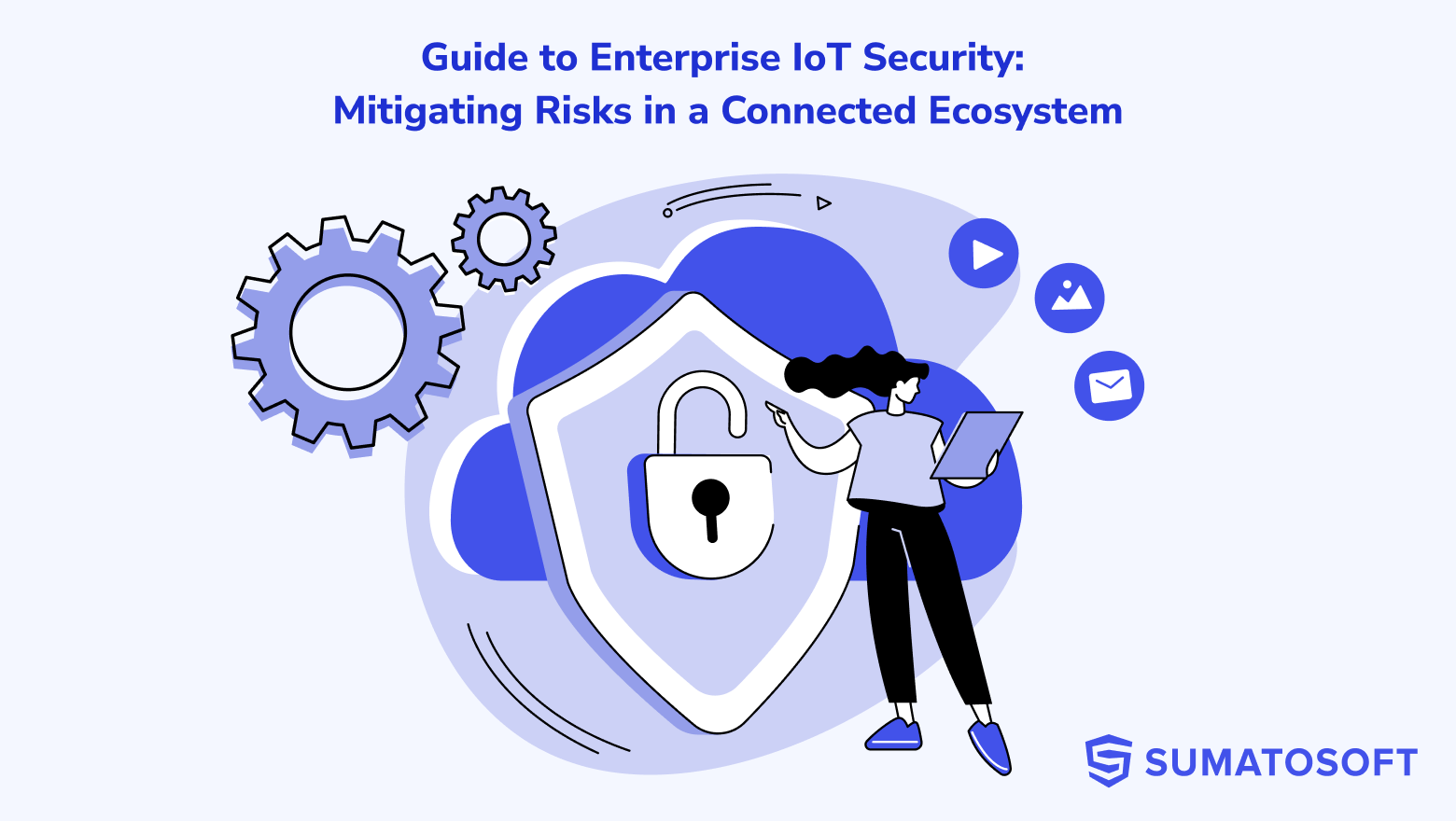Expert Guide to: IoT Architecture
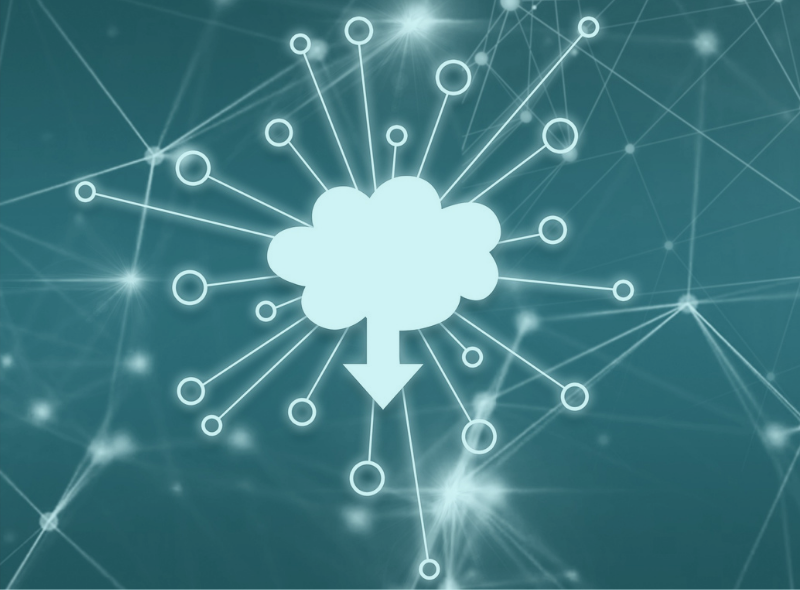
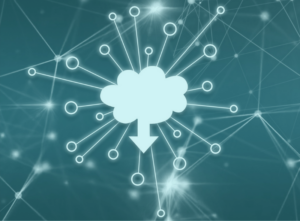
You probably have heard about the Internet of Things (IoT) a lot. The Internet of Things (IoT) is a rapidly emerging technology that gains traction worldwide, especially among businesses and software development companies. IoT has already become an integral part of people’s everyday lives.
- So what is IoT architecture??
- What are examples of IoT?
- How does it work?
All these questions are covered in the article you are looking at.
Enjoy reading!
What is IoT
The Internet of Things (IoT) architecture is a network of physical devices (so-called “things”) that collect and exchange data with other devices and systems over the internet. The devices range from gadgets in the ordinary household (kitchen appliance, thermostat, smart scale, light switches) to sophisticated things such as autonomous cars, industrial equipment, or smart cities. There are different types of sensors that collect data. They can track geolocation, the temperature, the pressure, the state of something (like on/off), the air humidity, etc.
The number of connected devices is enormous! It exceeded 10 billion in 2019 and is expected to reach the 30 billion mark by 2025, which is almost 4 times more than the projections of the world population.
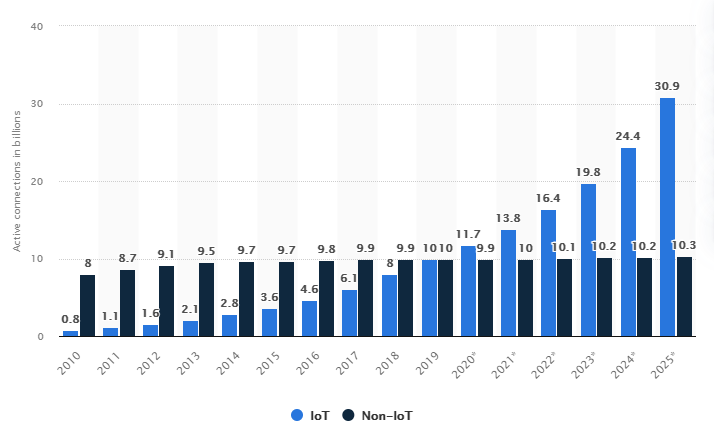
What advantages IoT architecture brings to businesses:
If you wonder what IoT architecture brings to businesses, you find a simple answer: the data. IoT brings much more data about everything you work with! How can it be helpful? Well, it can:
Improve efficiency & productivity
IoT makes it possible to automate the work of different devices in the IoT network that monitor, manage, or control some functional units. Furthermore, deep analytic platforms may provide insights to managers and business leaders. Analysis can give some insights into ways to improve manufacturing processes or make supply chains more efficient.
According to the report from Morgan Stanley company, the introduction of IoT had the greatest impact on improving operational efficiency and productivity.
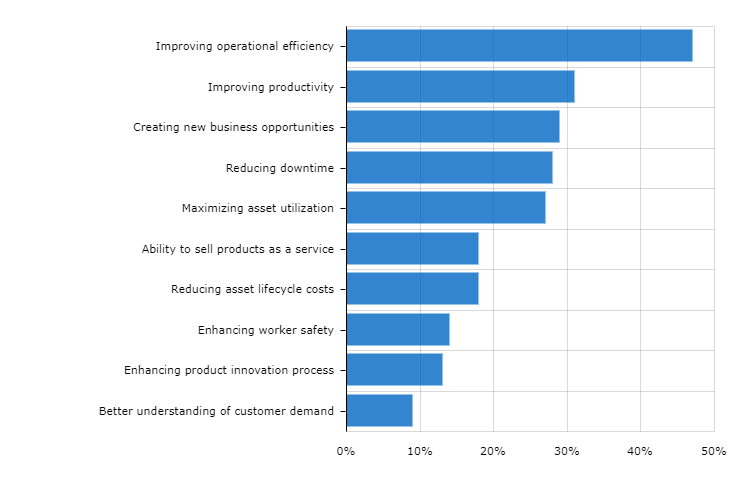
Brings new business opportunities:
The analytics IoT provides both new business opportunities and helps to reform traditional industries. IoT is another way to look at things and gadgets around you.
With more data available on customer preferences through IoT devices, businesses get new options:
- they can identify and provide the real value customers are seeking to
- deliver new products and services based on new information about customer experience or updating existing ones.
- innovate traditional business models.
Reduce costs
Have you wondered how to keep business equipment running at peak efficiency? Maybe you wonder how to reduce the likelihood of unexpected equipment breakage?
Maximizing equipment performance and predictive maintenance becomes possible thanks to IoT. IoT architecture can troubleshoot office equipment in real-time and catch errors before they happen due to real-time diagnostics. The IoT presents you with full control over all machinery, tools, and equipment. Detecting a piece of equipment falling before it happens minimizes costly downtime for repairs.
Real-time maintenance equipment and preventing possible downtime allows a company to run at full capacity and results in a bigger profit.
Improve customer experience
Smart devices at home, voice assistance, smartwatches, and all the staff with the “smart” prefix directly communicate with users on a daily basis. That data helps businesses to understand user behavior and develop more accurate targeted advertising, price policy, and marketing strategy in general.
According to Harvard Business Review, 62% of respondents say IoT increased their customer responsiveness after they introduced technology. That is a great result.
More trustworthy image of the company
Quite a simple remark: IoT is a trend that will add more reputation to your company if you use it. IoT software development provides high-tech solutions that make a positive impression on customers, investors, partners, and employees.
Examples of IoT architecture?
What are examples of IoT architecture?
IoT examples:
- Smart homes and gadgets for smart homes;
- Traffic surveillance and management applications;
- Smart city lights;
- Smartwatches and fitness trackers;
- Health monitoring patches;
- Helmet crash sensors;
- Smart smoke detector;
- Air quality sensors;
- Digital finger, which is used to turn on/off the switches;
- And much more.
Stages of IoT architecture. Overview:
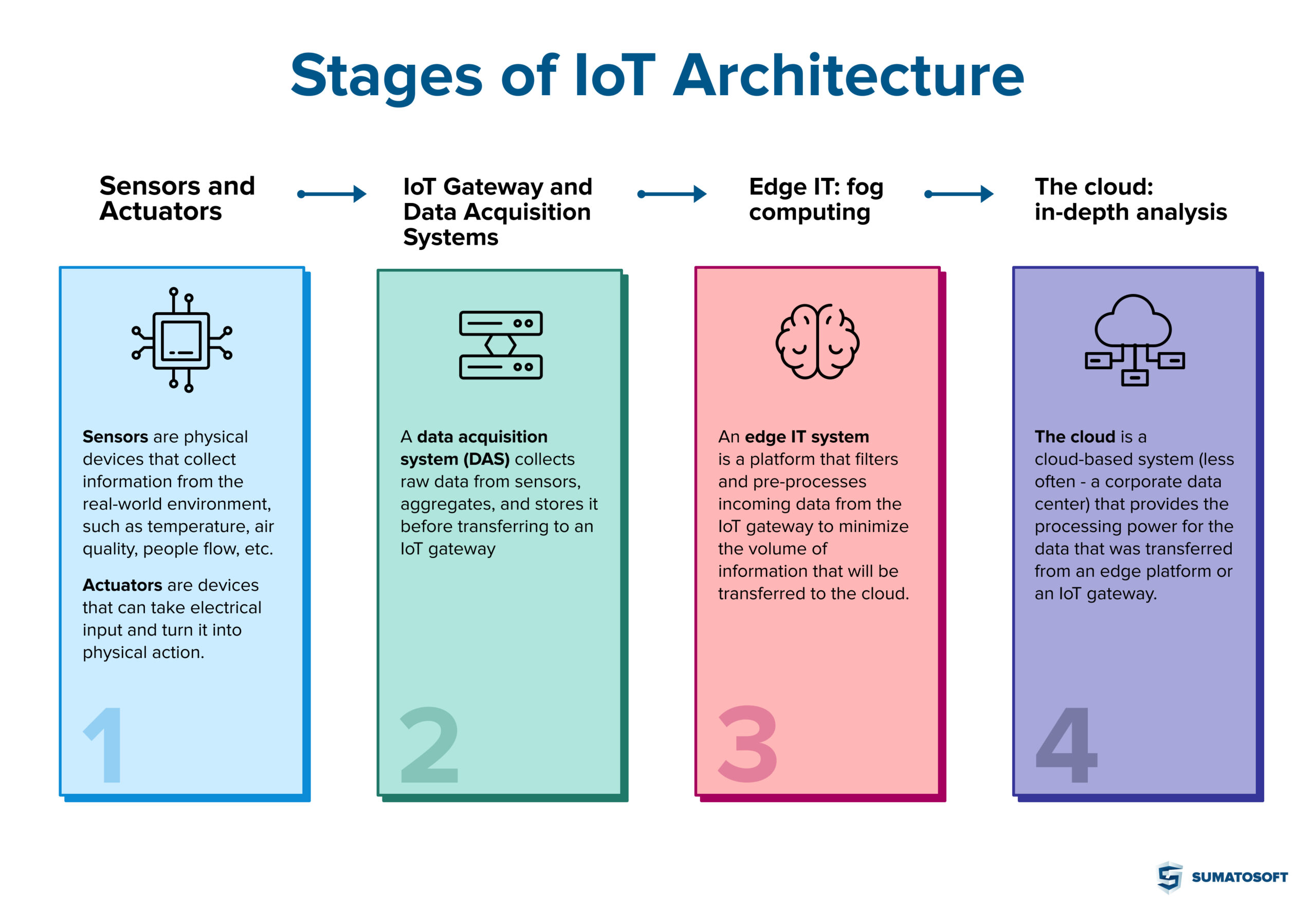
- Sensors and actuators
Sensors and Actuators are the basic “things” of IoT architecture. Sensors are physical devices that collect information from the real-world environment, such as temperature, chemical composition, blood pressure, air quality, people flow, status data, etc. In other words, sensors convert some physical phenomenon into a digital form.
Actuators are devices that can take electrical input and turn it into physical action. An example of sensor-actuator collaboration is switching off the light in a smart home when nobody is around. Ordinary electrical sensors and actuators have been around for decades, however, other technologies like machine learning, big data, 4g, and 5g network architecture bring that collaboration to a new level.
- IoT Gateway and Data Acquisition Systems
A data acquisition system (DAS) collects raw data from sensors, aggregates, and stores it before transferring it to an IoT gateway. The biggest challenge here lies in providing support for multiple connectivity sensor protocols (because all things are different types of devices) and developing a DAS system that will be hardware and OS-agnostic.
An IoT gateway is an intermediary between connected devices and the cloud. It is a device or platform that gets the data from DAS, compresses it, and passes it to the cloud. IoT gateway and DAS are necessary for several issues:
- ensure the security of the data travel between the devices and the cloud
- to pass the data from devices to the cloud
- to transmit control commands going from the cloud to things
Thus, DAS and an internet gateway aggregate and compress a great mass of data before passing it to the cloud platform for further analysis. All the information inside IoT architecture goes through an IoT gateway.
- Edge IT: fog computing
An edge IT system is a platform that filters and pre-processes incoming data from the IoT gateway to minimize the volume of information that will be transferred to the cloud. It is also called fog computing or fog network.
The fog can be viewed as a cloud that is close to the ground. The fog architecture is physically located near the data source. It allows for filtering and analyzing data from sensors through locally placed fog nodes before the data goes to the cloud.
IoT architecture can exist without an Edge IT platform, however, an edge platform brings significant benefits for IoT projects:
- decrease the cloud network load
- reduce the transmission cost of the data
- real-time response to “things”
- provide monitoring of IoT devices and their activities
- The cloud: in-depth analysis
The cloud is a cloud-based system (less often – a corporate data center) that provides the processing power for the data that was transferred from an edge platform or an IoT gateway. The cloud can be powered with analytics software, visualization tools, AI, and machine learning for in-depth analysis and processing of the data.
The cloud element is what makes IoT architecture useful for businesses and people. The gathered information is expected to provide insights for making crucial business decisions and identifying trends and patterns.
Conclusion
So, IoT is a technology that became possible thanks to the emergence of other technologies, such as 4g, 5g, and machine learning. The IoT market is enormous, and it continues to grow. Things are the basis of the IoT architecture, while the collaboration between sensors (things) and actuators is not new, the future of IoT technology is very promising. IoT has already made a great contribution in developing smart homes and monitoring tools in medicine, but the further impact on all spheres will be much bigger.
Let’s start
If you have any questions, email us info@sumatosoft.com

